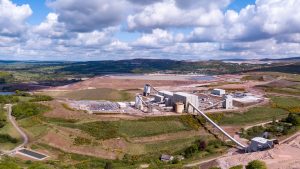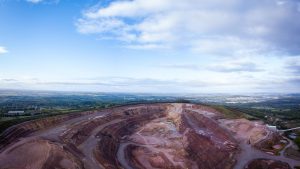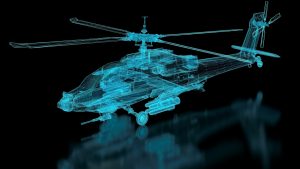The potential of Tungsten West’s Hemerdon mine extends far beyond its moorland locale, to the breadth of the UK and beyond.
Tungsten is often referred to as ‘the metal of the future,’ such is its centrality to a multitude of modern industries. It possesses unparalleled strength, durability, and heat resistance – key technical properties that make it highly sought after.
In aerospace, tungsten is used in turbine blades, radiation shielding, satellite propulsion, nozzles, ballast weights, and jet engines. Tungsten carbide and heavy alloys are used in wind turbine bearings, gears, counterweights, and blades. Tungsten sulphide compounds can be used in the solar cell industry to improve energy generation.
As the world begins to turn to electric vehicles (EVs), tungsten once again demonstrates its vitality; its high melting point and high density make it ideal for use in EV batteries as it can weather the high pressure and temperatures that come from the charging and discharging process.
Tungsten’s use in fusion energy devices
Such is the fast-moving nature of global progression that new applications for tungsten are being constantly realised. Perhaps the most exciting of these centres on a reaction that has the potential to provide a virtually unlimited supply of clean and sustainable energy – fusion.
In fusion energy devices, tungsten will be required for radiation shielding and plasma-facing components. Due to tungsten’s excellent thermal conductivity, it helps to dissipate heat and prevent damage to the reactor in the fusion unit.
Additionally, tungsten has a low sputtering yield, meaning that it resists erosion and maintains its structure when bombarded with high-energy particles. This is important in a fusion reactor, as the plasma particles can cause damage to the reactor walls if not properly contained. It also has a high neutron irradiation resistance, which is crucial in a fusion reaction where high-energy neutrons are produced.
Fusion energy produces no greenhouse gases and generates minimal waste, making it a viable source for the future. It can help reduce dependence on finite fossil fuel resources and solidify the energy security and energy independence of countries that may previously have been stifled by the energy access gap.
The importance of UK tungsten mining
Tungsten shares an entirely cyclical reliance with the world. They are co-dependent; tungsten’s potential cannot be unlocked if it isn’t given the platform from which to do so by national governments, and the success of future global industries cannot be actualised if tungsten fails to be exploited.

China has been the main source of imported tungsten into the US since 2017, representing approximately 29% of its total tungsten imports from 2018 to 2021.
For the UK, relying on imported tungsten places it in a vulnerable position, subject to the whims of international markets and geopolitical tensions. By developing domestic tungsten mining capabilities in the UK, national security would be strengthened, and a stable supply of this crucial material would be cemented, allowing national industries to be safeguarded and autonomy preserved.
The UK has another motivating factor to contend with. Its status as a world leader in green energy and decarbonisation technology is somewhat reliant on the constant sourcing of the materials necessary to continue this drive.
The UK Government has outlined a mission to decarbonise the country and achieve net zero greenhouse gas emissions by 2050.
To achieve this, the UK Government has implemented various strategies and initiatives. These include:
- Transitioning to renewable energy sources;
- Improving energy efficiency;
- Promoting electric vehicles: The government has set a target to ban the sale of new petrol and diesel vehicles by 2035 and promote the uptake of electric vehicles. This includes providing grants for electric vehicle purchases and expanding charging infrastructure;
- Investing in research and development: The UK Government has committed to investing in research and development to develop new technologies and innovations, such as fusion energy, that can help decarbonise various sectors;
- Setting carbon budgets; and
- International co-operation: The UK Government is actively involved in international efforts to address climate change, such as through the United Nations Framework Convention on Climate Change and the Paris Agreement.
Overall, the UK Government’s mission of decarbonisation is aimed at reducing greenhouse gas emissions and transitioning to a low-carbon economy. The sectors that are crucial to propelling this transition are, in turn, dependent on sources of tungsten.
Despite this, the UK Government is currently doing very little to facilitate tungsten mining in the UK. Whilst there appears to be support for new businesses developing battery technology, there is limited appetite to support the critical minerals companies that will supply them.
Planning and permitting requirements must be accelerated to adapt to the fast-moving nature of the sector, and businesses providing the materials critical to achieving net zero should qualify for government support so that they can support UK industries.
It is vitally important to note that cutting red tape does not have to mean cutting corners too. By listening to business leaders, the government has a golden opportunity to shape a thriving critical minerals sector, securing supply chains and attracting widespread investment.
The Hemerdon mine has great global potential for the UK
The UK Government first published its Critical Minerals Strategy in July 2022. The strategy aims to accelerate the growth of the country’s domestic capabilities to mine critical resources. It states: “The world in 2040 is expected to need four times as many critical minerals for clean energy technologies as it does today.”

26 materials were assessed for their potential criticality to the UK economy in terms of their global supply risk and the UK economic vulnerability to disruption. Tungsten is one of those materials, and so too is tin – both of which are found at the Hemerdon mine, Tungsten West’s 100% owned project located in Devon, UK.
Since 2019, when Tungsten West purchased Hemerdon, the company has focused its efforts on restarting operations at the site. Hemerdon hosts the fourth largest tungsten-tin deposit in the world and is therefore positioned to become the Western world’s largest producer. The gravity of this prospect is not lost to the Tungsten West team.
However, the global scale of Hemerdon’s potential must not detract from the role of the community in the success of this project. Tungsten and tin were first found at the site in 1867, its resources contributed to the war effort in the Second World War, and generations of local workers and residents have helped develop the potential of the mine. Tungsten West is merely the custodian that is trusted to realise this continued potential.
The company has now submitted all four of the key permits required for restarting operations at Hemerdon, working closely with the Environment Agency, Devon County Council, and the local community. The Mining Processing Facility approval will give Tungsten West the green light to switch the plant on and begin producing tungsten and tin.
Hemerdon is a microcosm of the UK’s critical mineral potential. Throughout history, mining has been an integral part of the British economy, just like it has for the region of Devon; for both, the emerging frontier of green transition minerals brings with it a new chapter in the story.

To unlock the undeniable benefits of allowing tungsten mining within the UK, its importance must first be recognised. If the opportunity is seized, it could pave the way for a prosperous local, domestic, and global future.
Please note, this article will also appear in the sixteenth edition of our quarterly publication.








